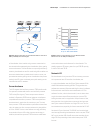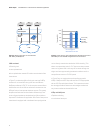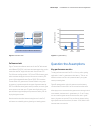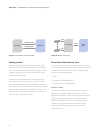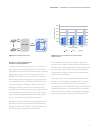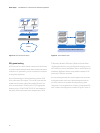
Gaming protocol
How does this gaming protocol work? A player sends a UDP
packet of 40–200 bytes in size to the game server. The game
server receives the packets, does its own processing, and then
updates all the players by sending a 2,000-byte UDP packet
(as represented in Figure 9).
We know that the virtualization will increase the round-trip
network latency, but we are not sure by how much. In theory
we also know that enabling VMDq and NetQueue will improve
the network latency. We searched both internally and externally
for data related to the impact of virtualization on latency sensi-
tive applications, but we were not successful. Therefore, we
decided to do our own tests in Intel labs.
Round-trip network latency tests
In order to run the round-trip network latency test, we used the
micro-benchmark Netperf 2.4.4, the UDP latency test and the ESL
workload, which consists of UDP packets. The following three
scenarios are being compared here:
1. Native
2. Virtualized with VMDq/NetQueue
3. Virtualized with no VMDq/NetQueue
Scenario 1: Native
The setup and configuration, as shown in Figure 10, includes
eight clients connected to eight 1-GbE ports of a 1G/10G link
aggregation switch (Force 10 S50*) and the Intel Xeon processor
7300 server connected to 10G port of the switch via Intel®
82598 10GbE CX4 NIC. SLES10 SP1 is the operating system
installed on all the clients and servers, and there are eight
parallel streams of UDP latency tests being run from the
clients to the server.
40–200 bytes UDP
2,000 bytes UDP
Game Player Game Server
Figure 9. Game network protocol overview.
10 GbE
Native
Server
Force 10 S50*
Client 1
1 GbE
Client 8
1 GbE
Figure 10. Native lab test setup.
8
White Paper Consolidation of a Performance-Sensitive Application







